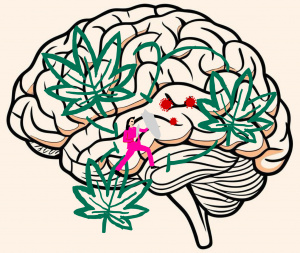
Artstract created by C. Geraci
Have you ever smoked weed? If you haven’t, recent research has shown that you may want to consider it, as it may have neuroprotective roles on our body’s neurons.
The Endocannabinoid System (ECS)
The system in the brain that cannabis targets is the endocannabinoid system (ECS). Delta-9-tetrahydrocannabinol, better known as delta-9-THC, is the main ligand, out of around 60 ligands, within marijuana that binds to the ECS’s two receptors: cannabinoid receptor 1 (CB1) and cannabinoid receptor 2 (CB2). CB1 receptors are concentrated with the brain and spinal cord, while CB2 receptors are more localized in the peripheral nervous system and more directly associated with regulating microglia and inflammation.1
CB1 receptors are G-protein coupled receptors (GPCRs) localized on pre-synaptic membranes of neurons that are activated in the absence of agonists like delta-9-THC. The binding of such agonists to CB1 receptors inhibits Ca2+ outflow from the presynaptic neuron while triggering a temporary increase of intracellular Ca2+ in the post-synaptic neuron. This triggers enzymes NAPE-PLD and DAGL to make arachidonylethanolamine (AEA) and 2-arachidononylglycerol (2-AG), respectively. AEA and 2-AG are the main endocannabinoids that bind to the CB1 receptors, further inhibiting the outflow of calcium and potassium, neurotransmitters release, and production of cAMP by inhibiting adenylyl cyclase. 1 This cycle can be seen in the upper portion of Figure 1.

Figure 1. This shows the pathway that occurs after a ligand, such as delta-9-THC, binds to a CB1 receptor. 1
The lower portion of Figure 1 shows how a protein called B-arrestin is involved in the internalization of CB receptors, which may occur after prolonged exposure to CB1 receptor agonists. The binding of B-arrestins uncouples the G-proteins of the CB1 receptor and stimulates internalization, leading to a tolerance to endocannabinoids.1 For more information on the pathways of the ECS, click here.
And that tolerance may be what you think of when you think of people becoming addicted to smoking weed. But what positive effects can occur when you consume cannabis or delta-9-THC?
How Endocannabinoids Are Protective
Well, the endocannabinoid lipid molecules similar to AEA, such as palmitoylethanolamide (PEA) and N-oleoylethanolamide (SEA), have been shown to anti-inflammatory and neuroprotective actions. PEA and SEA do this by inhibiting fatty acid amid hydrolase (FAAH) and monoacylglycerol (MAGL), the enzymes that degrade AEA and 2-AG, respectively. With increased levels of AEA and 2-AG, neurodegeneration is prevented. Considering a mouse study where mice were treated with SEA, 2-AG levels were increased before an increase of CB receptor expression, confirming that SEA interferes with the ECS system.2
But what makes the increase of 2-AG and AEA neuroprotective? One role to consider is that of microglia, which play a large role in neuroprotection. Microglia have CB2 receptors on them, and chronic activation is generally considered detrimental for neuronal health. Since 2-AG and AEA are inverse agonists of the ECS in microglia, they inhibit their activation, decreasing prolonged microglial immunoreactivity, therefore protecting neurons from being unnecessarily degraded. 2 For more information regarding what PEA and SEA do, look at Figure 2 or click here.

Figure 2: This illustrated the neuroprotective effects that AEA, PEA, and SEA have on neurons. 1
Aside from microglia, astrocytes also play a large role in neuroprotection. Similar to microglia, astroglial CB1 and CB2 receptors play critical roles in inflammatory responses, with activation of these receptors protecting neurons against oxidative stress, apoptosis, and nitric oxide. 2
Endocannabinoids & Neurodegenerative Diseases
Looking at neurodegenerative diseases, is has been shown that CB2 receptors and FAAH are overexpressed during Alzheimer’s disease, leading to neurotic plaque buildup in astrocytes and microglia. Administration of MAGL and FAAH inhibitors led had anti-inflammatory effect on these glial cells, reducing amyloid-beta deposition. The ECS system has also been shown to have positive effects on dopaminergic neurons in Parkinson’s disease and neuronal regeneration in multiple sclerosis. Therefore, the ECS, cannabis, and delta-9-THC have the potential to treat neurogenerative disease and stimulate neuroprotection within the brain. 2 For more information on that, click here.
Conclusion
In conclusion, microglia and astrocytes are coupled to functions related to inflammatory production, pro-survival changes, resolution of neuroinflammation, and protection from toxic metabolites. The contribution of eCB signaling is relevant to protection of neurons, and further research should be done to determine whether the use of medical marijuana can effectively target neurodegenerative diseases without significant negative side effects. If that research is promising, it may suggest that cannabis be used as a preventative treatment for such diseases, promoting its use by the general population.
Footnotes
1Kendall, D., Yudowski, G. “Cannabinoid Receptors in the Central Nervous System: Their Signaling and Roles in Disease.” Frontiers in Cellular Neuroscience, vol. 10, no. 294, 2017, pp. 1-10, doi: 10.3389/fncel.2016.00294.
2Kasatkina, L.A., et. al. “Neuroprotective and Immunomodulatory Action of the Endocannabinoid System under Neuroinflammation.” International Journal of Molecular Sciences, vol. 22, 2021, pp. 1-35, https://doi.org/10.3390/ijms22115431.